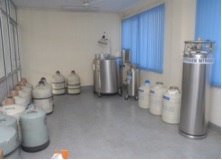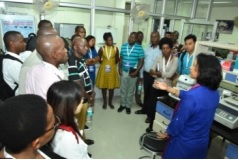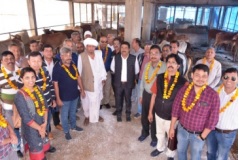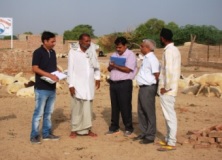Division of Animal Genetic Resources
AGR Division has been engaged in developing formats for breed characteristics, survey strategies, and breed description methodologies. The Division of Livestock Information and Management catered to the installation of the then state-of-the-art computers, their functions, and their use in livestock data management. As noted subsequently, the functioning of these two divisions was complimentary, and at places overlapping. Hence, during 1987 the two divisions functioned as a single unit due to inadequate staff during the year. Metamorphosis continued as, during 1987, the two divisions viz. Animal Genetic Resources and Animal Conservation were merged into Animal Genetic Resources and Conservation Section. It continued for two more years. In 1991 a new section was framed as a section of Animal Gene Bank. During 1991-92, the section of Animal Gene Bank was reframed as Animal Physiology and Reproduction section. Reorganization continued as during 1992-93 the then ICAR-NBAGR had one section and two units as:
(i)Livestock Information and Management Section
(ii) Animal Genetics Resources Unit
(iii)Animal Conservation and Gene Bank Unit.
During 1994-95 sections and units were again reframed as:
(i)Livestock Information and Management Unit/Computer Unit
(ii)Animal Genetic Resources and Conservation Section
(iii)Animal Physiology and Reproduction Section.
During 1996, the Animal Physiology and Reproduction Section were merged into Animal Genetic Resources and Conservation Section. In 1997, the naming was again changed to Animal Genetic Resources Division. National GeneBank was made functional in 2002 and ex situ conservation of livestock biodiversity was initiated. Livestock Information and Management Unit was recreated in 2021 and very recently Breed Registration Cell has been created within the division in September 2021 for the fast address of the breed registration process. At present Animal Genetic Resources Division is engaged in
- Phenotypic characterization
- Sustainable utilization
- Conservation of indigenous livestock and poultry breeds.
The phenotypic characterization is accomplished through systematic/pilot field surveys to assess the socio-economic status of the farmers, flocks/herd structure, population status, feeding, breeding and management practices, phenotypic characteristics, body biometry, and production performance, and marketing of live animals and products. The production performance of local breeds is evaluated and recorded under agroclimatic conditions of their habitat. The surveyed breeds/populations have been documented in the form of breed monographs, breed descriptors, and charts in addition to research publications. Based on the information, new strategies have been formulated for the improvement and conservation of the breeds under the field conditions. The in situ conservation for breeds of various livestock species has been implemented.
In addition, the Division is also working in the frontier areas of long-term ex-situ conservation of germplasm, value addition to the indigenous animal and poultry resources, registration of new indigenous breeds, sensitization of stakeholders, encouragement for utilization and conservation through Breed conservation Award.







